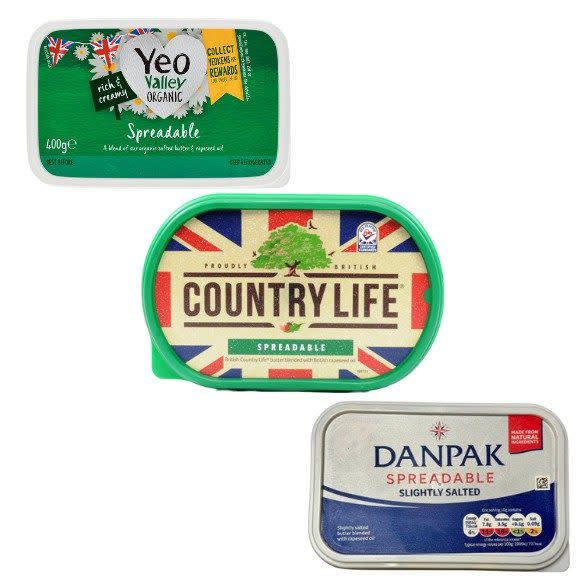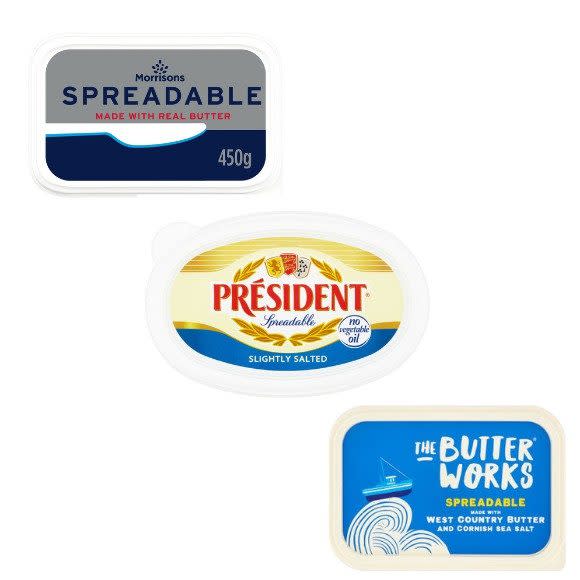My butter lives in the duck-shaped dish my father gave me many years ago. The duck head is a little wonky where it’s glued on, but it sits proudly on the work surface next to my grandmother’s pepper mill.
I’m in the minority: most of us buy Lurpak, Anchor or one of the supermarket own-label equivalents in a plastic container. They promise that it can be spread directly from the refrigerator. According to market research analysts Kantar, we buy one-third more butter “spreads” than regular paper- or foil-wrapped blocks of butter.
I understand Hard butter is annoying. When I try to spread it on bread, the bread crumbs tear. With modern central heating, keeping butter out of the fridge runs the risk of it turning dark yellow and smelling bad unless your turnover is reasonably high. Anyway, in our minimalist kitchens, most of us prefer to keep our butter neatly out of sight.
Spreadable butter has been a growing market since the early 1990s, when it first came to the UK to compete with margarines such as Flora (New Zealand gets the credit for the invention; it’s a big deal for them).
Until a decade ago, kiwi fridges included hot “butter softeners” to keep it at the perfect temperature. The tradition was abandoned and many New Zealanders were outraged when someone said it made no sense to keep a heated container in the cooler).
The method for making real spreadable butter is based on butter’s complex mixture of fats, all of which have different melting temperatures. By melting the butter and cooling it slowly, the fats with the lowest set point can be removed, leaving behind the fats with the higher set point, which remain soft in the refrigerator. To make butter again, a certain amount of processing is required (remixing the milk solids and water separated during melting), but it’s still just butter.
That’s not the case with most things you’ll find in the supermarket anymore. A very small number of spreadable 100 per cent butters are still available (notably Kerrygold, Président and the M&S version). Other manufacturers have found an easier way: beating softened butter with about half its weight in oil. Except it’s no longer butter, but legally butter must be at least 80 percent butterfat. For example, Lurpak Spreadable consists of 52 percent butterfat and 26 percent rapeseed oil; water makes up most of the rest; Anchor Spreadable, on the other hand, consists of approximately 41 percent butter and 33 percent oil.
The process is so simple that you can easily do it yourself and save money. To make a spreadable Anchor, bring 200g butter to room temperature, then beat with 145ml oil and 4-5 tablespoons room temperature water with an electric mixer. Beat for about a minute until you achieve a smooth, mayonnaise-like consistency. Pour into a tub and cool. This much. 400g of spreadable Hoe costs £2.27 (based on average costs), saving £1.08 on the cost of the store-bought tub.
For manufacturers, this method is a great opportunity because oil is much cheaper than butter. And by using almost the same branding on the spreads as on the actual butter packaging, they can charge almost the same price. Yes, the packaging states that it is a mixture and calls it “spreadable” rather than “spreadable butter”; But that’s not what catches the shopper’s eye when grabbing the conventional tub. On top of that, it’s quite confusing when there’s another range of products called “butter spreads” like Clover or I Can’t Believe It’s Not Butter, which contain buttermilk instead of butter, as well as plenty of ingredients like palm oil and the like. flavors that are markers of ultra-processed foods.
That’s right, “spreads” made with a mixture of butter and rapeseed oil are lower in saturated fat than pure butter because rapeseed oil is lower in saturated fat than butter.
Although there is no consensus on this in the medical community, NHS guidelines still recommend that we replace saturated fats with unsaturated fats. As Professor Tim Spector, blogging in the British Medical Journal, points out: “No study has successfully shown that switching to a low total or saturated fat diet can reduce heart disease or mortality.”
But health benefits aside, can these not-so-good spreads taste as good as the real thing? Is it worth paying for the likes of Lurpak when the supermarket’s own labels can be half the price? To help me taste 15 cheeses from the cooler aisles, I enlisted the help of dairy queen and cheesemaking legend Mary Quicke, whose family has been making cheese on their Devon farm for 14 generations.
In the 1970s Quicke’s paved the way for a revival of artisanal cheesemaking in Britain, winning numerous awards along the way, expanding its range to half a dozen cheeses as well as whey butter, a by-product of cheese. An international cheese and butter judge, as well as the founder of the UK-based Cheese Academy, there is no one better qualified than Mary to judge whether spreadable butters are hitting the mark.
Value-for-money taste test


Lidl Danpak Spreadable Lightly Salted
£2.09 for 500g (42 pieces/100g)
It is very pale, soft and has a shiny, oily smell. You’d expect to get some flavor from the 64 percent butterfat, but the flavor largely comes from the cheap butter. You don’t want to spread this thickly.
Country Life British Driveable
£3.50 for 500g at Sainsbury’s (70p/100g)
It’s another pale fudge, containing only 50 percent butterfat and having very little scent, but a strong kale butter flavor. Strange. Enough to delay your toast.
Yeo Valley Organic Spreadable Butter and Rapeseed Oil Mix
£4.50 for 400g at Sainsbury’s (£1.12/100g)
I’m a fan of Yeo Valley and its organic properties are good, but this 50 per cent butter tastes strangely leafy vegetable-y, perhaps due to the less processed organic butter. Stick to regular butter.
Aldi Nordpak Spreadable Lightly Salted
£2.09 for 500g (42 pieces/100g)
Although very spreadable, it has the same unpleasant, cabbage-rapeseed taste as Country Life. At best, it is a lubricant used to moisten toast.
Tesco Butterpak Salt Spread
£2.09 for 500g (42 pieces/100g)
It has a soft texture, like a pale, thick tub of cream. It’s quite oily and you can smell it. While butter isn’t bad, it’s still not butter to me. It leaves a strange peppery roughness behind the palette.
Lurpak Lightly Salted Spreadable
£4.46 for 500g (89p/100g) at Tesco
Very oily, grape seed taste. The foretaste has a buttery note, but eventually flattens out.
Capa Spreadable Butter and Rapeseed Oil Mixture
£3.35 for 400g (84p/100g) at Sainsbury’s
It looks soft and shiny like margarine but tastes like cheap butter. It has a strange, wheaty and biscuity taste; Suitable for toast.
Aldi Greenvale Valley Spread
£2.09 for 500g (42 pieces/100g)
It is very similar to Anchor. It is very soft and primrose in color with a light oil aroma. The oil is relatively muted and has some buttery notes, but the oiliness appears when heated.
Lidl Dairy Manor British Spread Lightly Salted
Price T/C
It is very similar to the previous two. It has a slightly buttery, oily aroma. It’s a nice salt spray, but overall it’s a bit ordinary.
Waitrose Spreadables
£2.40 for 500g (48p/100g)
If you want something with less salt, go for this. Very oily and pale. I don’t really like the smell, but it has butter notes.
Kerrygold Pure Irish Butter
£2.55 for 250g (£1.02/100g) at Sainsbury’s
It appears yellow and has a strong buttery taste; There is no oil note. It’s quite salty and I’m not sure about its waxy texture. But it’s definitely reliable and I wouldn’t judge whether this was served in a cafe.


Président Spreadable Lightly Salted
£2.75 for 250g at Ocado (£1.10/100g)
It’s all butter and no oil here, but it’s still spreadable despite being on the firm side. For lovers of continental-style cultured butter, here’s one with a cheesy flavor. Butter with character.
M&S Soft Butter
£2.80 for 250g (£1.12/100g) at Ocado
It’s actually just butter; Just by looking at the texture I can tell that this contains no oil. I’m not sure if it’s spreadable straight out of the fridge, but it would be great if spread thickly on toast.
Butterworks Spreadable West Country Butter
£2.40 for 250g at Waitrose (96p/100g)
Smoothly spreadable, it’s a bit bland at first but settles into a good buttery taste without the oily taste. The packaging needs careful inspection to realize that it is not pure butter but a mixture of oil and butter.
Morrisons Spread with Real Butter
£1.97 for 450g (44p/100g)
It has a higher butterfat content than some, but it has a slowly spreading flavor rather than cheap butteriness, and it’s not greasy at all. One you can use as a dip and for spreading. Best in terms of value.